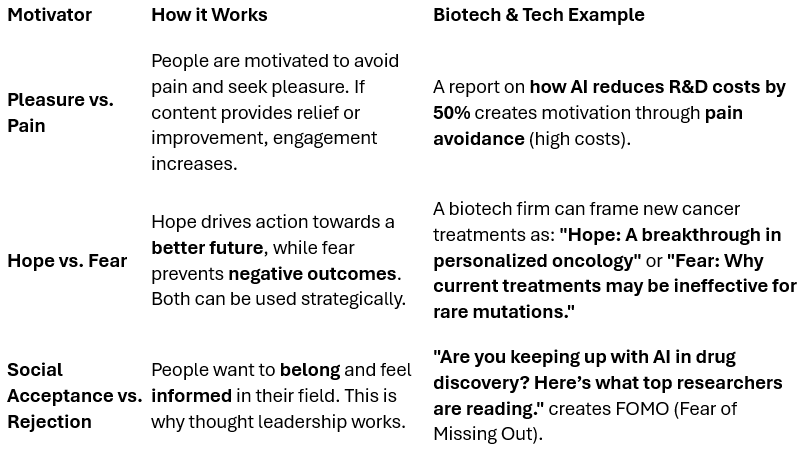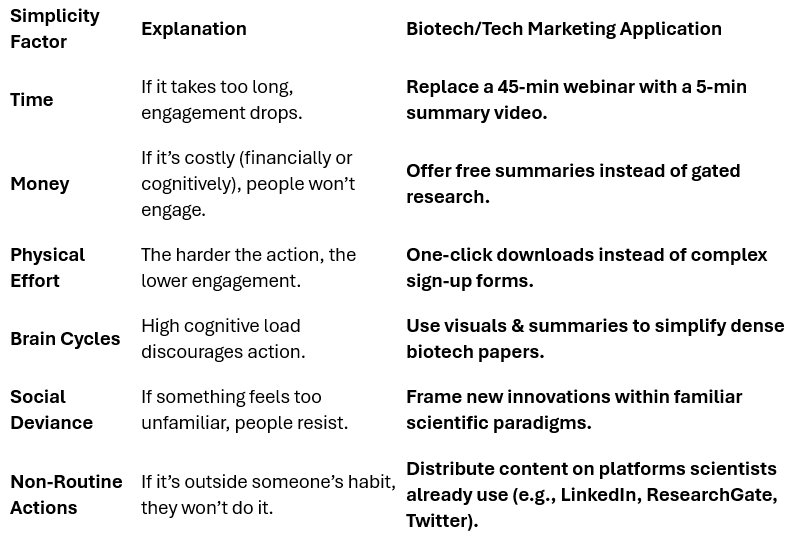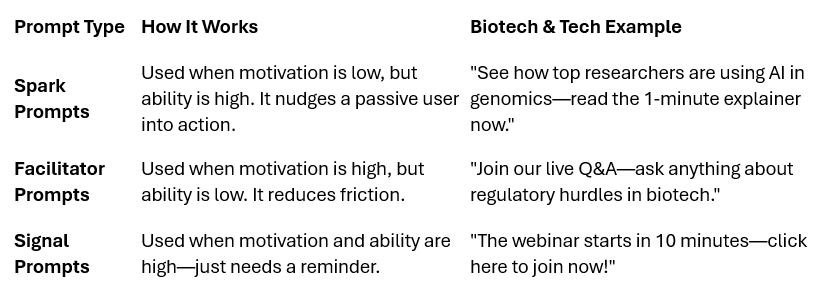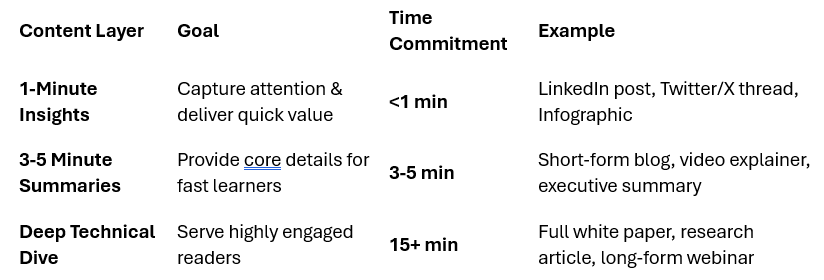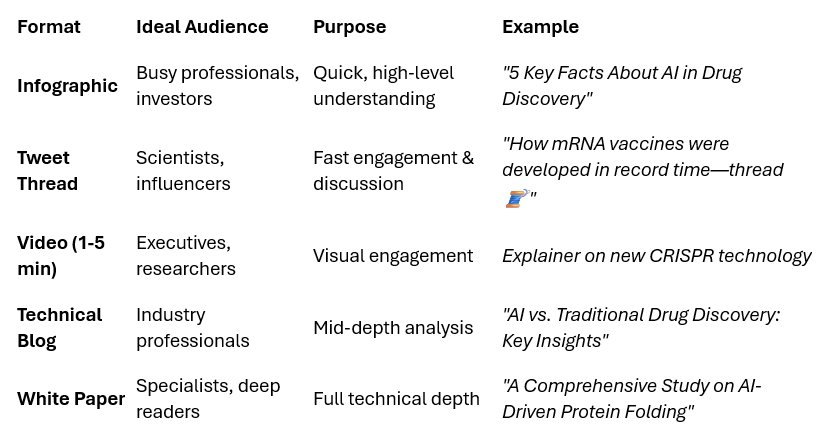Capturing Attention In The Attention Economy
Scientific Digital Marketing, Synthetic Biology, Nucleic Acid Therapeutics and Antibody Engineering, Biotech Writer
The attention economy is an unforgiving battlefield, where every piece of content competes not just with scientific papers, but also with the constant flood of emails, social media updates, and instant notifications. For biotech companies, research institutions, and life sciences marketers, the challenge is even greater—scientific innovations are inherently complex, requiring depth and rigor. Traditional long-form content, like white papers and dense reports, assumes that audiences have the patience to sift through detailed analyses. But the reality is starkly different. Even the most highly trained scientists, executives, and investors are time-starved and attention-fragmented, often skimming LinkedIn posts and Twitter/X threads for quick insights instead of diving into 30-page PDFs. The old model of content delivery is failing in this new landscape.
So, how do you make highly technical biotech content engaging, shareable, and even viral? The answer lies in understanding human behavior, specifically, leveraging Fogg’s Behavioral Model (FBM) to ensure that content is not just informative, but actionable, digestible, and easy to engage with. By strategically balancing motivation, ability, and prompts, biotech marketers can create content that captures attention, reduces cognitive friction, and compels action. This article breaks down why traditional biotech content struggles in the attention economy, how to apply Fogg’s Behavioral Model to increase engagement, and how the 80/20 content strategy can help biotech companies maximize impact without losing scientific credibility.
The Attention Economy and Why Biotech Content Struggles
In the digital world, attention is currency. Content competes not just with academic papers but with TikToks, memes, and push notifications. Scientific marketers face a paradox:
The complexity of biotech demands depth → requiring detailed white papers.
The modern audience demands instant gratification → rejecting anything that feels like too much work.
Long-form white papers often fail because:
They demand too much effort. Reading a dense 20-page report is cognitively expensive.
They lack an immediate reward. Readers don’t get an instant dopamine hit.
They aren’t designed for action. They inform but don’t compel a next step.
What is the Attention Economy?
The attention economy is the modern landscape where attention is a finite and valuable resource—arguably more valuable than money. People, companies, and advertisers are constantly competing to capture and retain audience attention.
Herbert Simon, a Nobel-winning economist, predicted this shift back in the 1970s, stating:
"A wealth of information creates a poverty of attention."
This is exactly the challenge biotech marketers face today. Scientists, researchers, and industry professionals have an overload of information but a limited cognitive budget to process it all.
How the Attention Economy Works
Think of attention as mental bandwidth—a finite resource. Every second spent on a LinkedIn post, webinar, or white paper costs the reader mental effort. Marketers must compete not only against direct competitors (other biotech companies) but also against:
Social media notifications
Breaking news in the industry
Emails, meetings, and daily work tasks
Other scientific papers and reports
Entertainment (yes, even scientists scroll TikTok and Twitter/X!)
In biotech, the challenge is even greater because the content is inherently complex. This means that traditional long-form formats—like white papers—often fail not because they lack valuable insights, but because they demand too much effort from an already overloaded audience.
Why Biotech Content Struggles in the Attention Economy
1. Biotech Content Demands Too Much Cognitive Load
Biotech content is naturally complex and dense. Unlike consumer products, where a quick tagline can summarize the benefits, biotech innovations often involve:
Deep scientific explanations
Technical jargon
Regulatory frameworks
Data-heavy reports
Reading a biotech white paper is like lifting a heavy mental weight—it requires focus, patience, and prior knowledge.
Example of Cognitive Load in Biotech Content:
White Paper Title: "Optimizing mRNA Stability Through Lipid Nanoparticle Delivery for Enhanced Intracellular Uptake."
Mental Load: High. The title alone requires understanding of molecular biology, drug delivery mechanisms, and pharmacokinetics.
Solution: Reframe as "How to Improve mRNA Drug Delivery: A Breakthrough in Stability and Uptake." This lowers cognitive effort while keeping depth.
🛑 Problem: If content feels like work, even the most motivated scientists will delay engaging with it.
✅ Fix: Reduce complexity through better formatting, visuals, and simplification without losing scientific accuracy.
2. Biotech Content Lacks Immediate Gratification
People are reward-driven, and digital platforms like Twitter, LinkedIn, and even scientific news aggregators train audiences to expect quick payoffs.
Problem: Traditional biotech content delivers value at the end (after reading 10+ pages), but modern audiences expect instant insights.
Comparison:
Social Media Post: "New research shows that CRISPR may soon cure sickle cell disease. Here’s why this is a game-changer."
White Paper: "A 35-page report on the genome-editing implications for inherited hematological disorders."
Which one gets read first? The one that gives a quick takeaway upfront.
🛑 Problem: White papers expect readers to work hard before delivering value.
✅ Fix: Deliver a micro-reward early (a bold insight in the introduction, an infographic, or an executive summary with key takeaways).
3. Long-Form Content is Not Designed for Modern Consumption
Traditional biotech content assumes readers will start at page 1 and read to the end—but modern attention spans don’t work that way.
Studies show that people skim before deciding to commit to reading something long-form.
If the content looks overwhelming, they will skip it.
💡 Example of Poor vs. Good Content Design: 🚫 Typical White Paper: Dense paragraphs, no section headings, technical terms upfront.
✅ Modern Approach:
Bold takeaways at the start.
Clear section breaks with headers.
Bullet points and visuals to reduce effort.
How People Actually Consume Content Today:
Skim headlines and bullet points → Does this seem valuable?
Look for visuals or infographics → Can I absorb this quickly?
Decide whether to read in detail → Do I have time for this right now?
If step 1 or 2 fails, they will leave before even reaching step 3.
🛑 Problem: If biotech content isn’t formatted for skimming first, it will lose engagement before the message is even delivered.
✅ Fix: Structure content for "scannability" with subheadings, highlights, and visuals.
Biotech Content Lacks a Clear Call-to-Action (CTA)
Even when biotech content captures attention, it often fails to drive action because:
It’s purely informative (doesn’t tell the reader what to do next).
There’s no low-effort next step (e.g., no quick way to engage further).
💡 Example of an Ineffective vs. Effective CTA: 🚫 Ineffective: "For more details, read the full 40-page white paper here."
✅ Effective:
"Download the 3-minute executive summary now."
"Join our upcoming Q&A session with the lead scientist on LinkedIn."
"Watch this 1-minute video breakdown of the research findings."
🛑 Problem: No CTA means passive consumption, not engagement.
✅ Fix: Provide low-friction CTAs that don’t require immediate commitment but encourage further interaction.
How to Make Biotech Content Fit the Attention Economy
Since attention is scarce, biotech marketers must redesign content to fit how audiences consume information today.
Key Shifts to Make:
Some key Takeaways
Biotech content is valuable, but if it’s too hard to consume, it won’t be read.
Modern attention spans require bite-sized, instantly rewarding content.
Long-form content should be structured for skimmability and immediate impact.
Every piece of content should include an easy, low-friction next step.
The goal isn’t to dumb down biotech content, it’s to present it in a way that fits how people actually consume information today.
Using Fogg’s Behavioral Model to Drive Engagement
BJ Fogg’s Behavior Model (FBM) explains that behavior = motivation × ability × prompt. In simple terms, people will take action (e.g., engaging with your biotech content) when:
Motivation is high.
Ability (ease of taking action) is high.
A prompt is present at the right time.
Here’s how this applies to biotech content marketing:
1. Increase Motivation: Speak to What Your Audience Cares About
Motivation comes from personal relevance and emotional connection. In biotech, this means:
Frame content around impact. Instead of a white paper titled "Novel CRISPR Applications in Rare Disease Research," try "How CRISPR Is Unlocking Cures for Rare Diseases: What Every Researcher Needs to Know."
Use storytelling. Scientists love data, but they engage with real-world implications. Case studies, patient stories, and success narratives work better than pure technical exposition.
Create urgency. "New FDA regulations will impact your research are you ready?" makes the audience feel like they need to read your content.
2. Increase Ability: Make Consumption Effortless
If content feels like work, people will skip it. Reduce cognitive load by:
Breaking white papers into snackable formats.
60-second LinkedIn posts
Infographics summarizing key takeaways
A short Twitter/X thread linking to deeper content
Using clear, simple language. Avoid jargon overload. Even PhDs appreciate clarity.
Optimizing for skimmability. Use:
Bullet points
Bolded key phrases
Short paragraphs
3. Use the Right Prompts: Guide Action Strategically
Even highly motivated and capable people won’t act without a prompt. Examples:
“Download this 3-minute executive summary” (instead of a full white paper)
“Sign up for a live Q&A session” (instead of “read our dense report”)
“Join the discussion: What’s your take on this discovery?” (sparking engagement)
Prompts should be low friction, high reward like a quick signup, one-click PDF download, or a comment-driven discussion.
A Technical Breakdown of Using Fogg’s Behavioral Model to Drive Engagement in Biotech & Tech Marketing
Introduction to Fogg’s Behavioral Model (FBM)
At its core, Fogg’s Behavioral Model (FBM) provides a framework for understanding why people take action. It states that for any behavior to occur, three key factors must align simultaneously:
B= M × A × P
Where:
B = Behavior (Engagement, conversion, reading, sharing content)
M = Motivation (Does the user care?)
A = Ability (Is it easy to act?)
P = Prompt (Is there a trigger that pushes action?)
If any of these three factors is missing, the behavior (e.g., downloading a white paper, engaging with a biotech study, or signing up for a webinar) will not occur.
Let’s now break down each component in a biotech and tech marketing context, exploring theory, technical details, and practical application.
1. Motivation: Making Your Audience Care
Motivation in FBM is categorized into three core psychological motivators, each with two polar opposites:
Pleasure vs. Pain
Hope vs. Fear
Social Acceptance vs. Rejection
How Motivation Works in Biotech and Tech Content
In biotech and tech marketing, motivation isn’t just about interest in the topic—it’s about making the audience feel a personal stake in engaging with the content.
Breaking Down Motivation in a Technical Context
How to Apply Motivation in Biotech & Tech Content
Frame content around an emotional driver
Example: Instead of "Understanding Synthetic Biology,"
§ Try "How Synthetic Biology is Revolutionizing Medicine—Are You Ready for the Future?"
Use compelling hooks in intros
Example: "90% of biotech startups fail due to regulatory blind spots—are you prepared?"
Show personal or industry impact
Example: Instead of "AI in Drug Discovery,"
§ Try "How AI Could Help Your Lab Cut Research Time in Half."
2. Ability: Reducing Friction in Engagement
Even if motivation is high, people won’t act if it’s too difficult. Ability refers to how easy it is for someone to engage with the content, understand it, and take action.
The Six Elements of Simplicity (According to Fogg)
Fogg defines ability as a function of simplicity—reducing barriers that prevent action. There are six key simplicity factors:
How to Reduce Friction in Biotech & Tech Content
Break content into smaller, digestible pieces
❌ "Download our full 40-page report."
✅ "Get a 2-minute summary with key insights."
Use accessible language and clear structure
❌ "Emerging CRISPR modalities exhibit superior RNA-binding affinity for genetic therapeutics."
✅ "New CRISPR techniques improve gene-editing precision by 3x—here’s why it matters."
Make engagement as low-friction as possible
❌ "Sign up with your name, email, company, job title, and industry to get the white paper."
✅ "One-click download. No forms required."
Prompt: Triggering Action at the Right Moment
A prompt (also called a trigger or cue) is what nudges someone to take action at the right moment. Even if motivation and ability are high, without a well-timed prompt, behavior doesn’t happen.
Types of Prompts in Digital Marketing
How to Use Prompts Effectively in Biotech & Tech
Use urgency-based prompts
"Regulatory changes are coming—are you ready?"
"The first 100 sign-ups get exclusive access to the case study."
Use social proof as a prompt
"Join 5,000+ researchers who already downloaded this report."
"See what industry experts are saying about this breakthrough."
Create frictionless action triggers
"One-click to download."
"Click below to see the top findings now."
Conclusion: Turning FBM Into a Biotech & Tech Marketing Framework
By aligning motivation, ability, and prompts, biotech and tech marketers can drive higher engagement and conversions. Here’s the optimized framework:
Increase Motivation
Use hope, fear, and social triggers to make content emotionally engaging.
Frame biotech/tech innovations as game-changers with clear impact.
Improve Ability
Reduce cognitive and physical effort to engage.
Use shorter formats, structured takeaways, and visuals.
Optimize Prompts
Use timing-based triggers (email reminders, social proof).
Offer low-friction actions (one-click downloads, short videos).
In the attention economy, the companies that win are the ones that make engagement feel effortless.
Why Some Biotech Content Goes Viral (And Others Don’t)
Virality isn’t just luck. Scientific content spreads when it:
Creates an emotional reaction (surprise, fear, excitement, inspiration).
Has high shareability (quickly consumable, easy to repost).
Offers social currency (makes the sharer look smart or ahead of the curve).
Encourages discussion (controversy, debate, or curiosity-driven questions).
For example:
A 1-minute animated explainer on a breakthrough therapy will likely outperform a 20-page PDF.
A hot take on a new study’s implications will drive more engagement than a dry abstract summary.
Key Takeaway: The "80/20" Approach to Biotech Content
80% of your effort should be making content easier to consume.
20% should be about deep, technical depth.
Start with engaging, easy-to-digest content, then provide a pathway to deeper exploration for those who want more.
The 80/20 Approach to Biotech Content: A Technical Breakdown
In biotech marketing, the 80/20 approach is about maximizing engagement by focusing 80% of effort on content format, accessibility, and delivery, and 20% on deep, technical depth. This method ensures that the most important insights reach the widest audience, while still providing the depth needed for those who want a deeper dive.
Why Does the 80/20 Rule Matter in Biotech Content?
Biotech audiences—scientists, researchers, investors, and regulators—don’t have time to sift through dense content. The traditional approach prioritizes depth over accessibility, but in the attention economy, that means losing engagement before your message is even absorbed.
The 80/20 approach optimizes biotech content by:
Making the most critical insights immediately digestible.
Encouraging progressive engagement (small actions that lead to deeper involvement).
Minimizing cognitive overload while still offering depth for serious readers.
Breaking Down the 80/20 Rule in Biotech Content
The 80% (Accessibility & Delivery) and 20% (Technical Depth) balance is achieved through structuring, formatting, and multi-format content strategies.
1. The 80%: Accessibility, Format, and Delivery
This portion of biotech content focuses on ease of consumption. Without making the content digestible, the audience never reaches the deep insights.
(A) Information Density & Layering
Key Principle: Deliver high-value insights quickly in multiple layers of depth.
Example of Layering in Biotech Content
LinkedIn Post: "New CRISPR advancement boosts gene editing efficiency by 3x—here’s why this is a game-changer. " (1-min engagement)
Blog Summary: "CRISPR efficiency has tripled due to a new base-editing technique. This improves precision and reduces off-target effects. Read our 3-minute summary." (5-min engagement)
Full White Paper: "We break down the chemistry behind these new base-editing advancements, including experimental methods, reaction mechanisms, and validation results." (15+ min engagement)
This tiered approach allows people to engage at their preferred depth.
(B) Optimizing for Cognitive Load
Key Principle: The harder it is to process, the fewer people engage.
Fogg’s Behavior Model states that reducing cognitive load increases action.
Biotech content should:
Minimize dense text → Bullet points, short sentences, visual highlights.
Use clear structuring → Headings, sections, key takeaways.
Use visuals → Diagrams, flowcharts, infographics.
Example of Poor vs. Optimized Format in Biotech
🚫 Poorly Formatted Abstract (High Cognitive Load)
"RNA interference (RNAi) technology represents a promising approach for gene silencing applications. However, challenges such as off-target effects, delivery efficiency, and stability in vivo necessitate optimized nanoparticle-based delivery systems to enhance therapeutic viability."
✅ Optimized Format (Low Cognitive Load)
🔬 RNAi for Gene Silencing – What’s the Breakthrough?
✅ Challenge: Off-target effects reduce RNAi efficiency.
✅ Solution: New lipid nanoparticle delivery increases stability 3x in vivo.
✅ Impact: Improves therapeutic viability for genetic diseases.
Why It Works:
Skimmable ✔
Key insight delivered immediately ✔
Easy to share ✔
(C) Multi-Format Content Strategy
Key Principle: One format doesn’t fit all.
Biotech audiences are diverse: researchers prefer white papers, executives prefer summaries, and investors engage with short explainers. Repurpose content across multiple formats to maximize engagement.
Why It Works:
Adapts content for different attention spans.
Increases engagement touchpoints across platforms.
Drives traffic back to long-form content.
2. The 20%: Deep Technical Depth
This is where scientific credibility comes into play. Once biotech professionals engage with the easy-to-consume content, they should have a pathway to in-depth material.
(A) Structure Technical Content for Consumption
Even long-form content should be formatted for clarity.
Example: White Paper Optimization
🚫 Poor Structure:
Abstract → Background → Methods → Results → Discussion (Traditional Format)
✅ Optimized Structure:
Executive Summary (Key Findings First)
High-Impact Graphs & Figures
Detailed Analysis (For Deep Readers)
Why? Researchers skim before deciding whether to read deeply.
Final Framework: How to Apply the 80/20 Rule in Biotech Marketing
Example Workflow for a Biotech Breakthrough
Hook: Twitter/X thread: "How AI-designed proteins are revolutionizing medicine. "
Summary: Blog post: "3-Minute Breakdown of AI-Designed Proteins in Drug Discovery"
Deep Dive: White paper: "Computational Protein Engineering: Methods & Clinical Applications"
Why the 80/20 Rule is Essential for Biotech Content
80% of content should focus on accessibility, engagement, and skimmability.
20% should be deep, technical, and structured for serious readers.
Multi-layered content ensures all audiences engage at their preferred level.
Progressive content depth keeps attention while maintaining credibility.
Winning in biotech marketing isn’t just about having great research—it’s about delivering it in a way that matches how people consume content today
Conclusion
Scientific breakthroughs deserve attention. The key is designing content that fits how people actually engage in the digital world.
Make it motivating. Make it effortless. Make it actionable.
The challenge for biotech marketers isn’t that their audience lacks intelligence or curiosity—it’s that even the brightest minds operate within the constraints of the attention economy. Scientists, researchers, and industry professionals are constantly bombarded with information, from research publications and grant proposals to regulatory updates and industry news. Even with the best intentions, they simply don’t have the cognitive bandwidth to engage with dense, long-form content unless it’s presented in an accessible and rewarding way. No matter how groundbreaking a biotech innovation is, if the content that explains it is too difficult to consume, it will struggle to gain traction. Traditional marketing strategies assume that quality alone will drive engagement, but in reality, content must also be designed for consumption. This means shifting away from cognitively taxing formats and toward layered, frictionless content experiences that fit seamlessly into the modern digital landscape.
By applying Fogg’s Behavioral Model, biotech marketers can engineer engagement by making content not just informative, but actionable and effortless to consume. When motivation, ability, and prompt are aligned, audiences are far more likely to engage—whether that means downloading a report, attending a webinar, or sharing insights with peers. The 80/20 content strategy takes this a step further, prioritizing skimmability and accessibility without sacrificing scientific depth. The goal is not to dilute technical rigor, but to make it more digestible, guiding audiences through progressively deeper layers of information. A one-minute LinkedIn post or infographic should spark curiosity, leading to a three-minute blog summary, and finally, for those who want the full picture, a comprehensive white paper or technical deep dive. This structured approach mirrors how modern audiences engage with content, ensuring that key insights reach the widest possible audience while still providing depth for those who need it.
This is not about dumbing down biotech content—it’s about amplifying its impact by presenting it in a way that aligns with how people actually consume information today. Biotech innovations deserve widespread attention, but attention must be earned, not assumed. In a world where even Nobel Prize-winning research competes with the dopamine-driven algorithms of social media, winning the battle for attention requires more than just great science—it requires great storytelling, strategic formatting, and effortless accessibility. The companies and institutions that succeed will be those that design content experiences as effectively as they design their technologies, making engagement not just possible, but inevitable. The future of biotech marketing belongs to those who can merge scientific depth with digital fluency—because in the attention economy, engagement is the currency that drives innovation forward.
Motivate your audience with emotionally compelling narratives.
Make engagement easy by simplifying consumption.
Use effective prompts to drive action and sharing.







